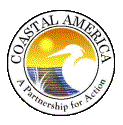



A Path to Wildlife Habitats
Project Purpose: The goal of the project is to establish adequate cover for wildlife utilizing herbaceous vegetation to provide breeding, nesting, hiding, resting, and feeding areas. The project will encourage the growth of natural food sources while introducing other food sources through the installation of selected herbaceous plants.
Brief Description: The Cape May County Technical School District (CMCTSD) is located on 82 acres of land that border the Atlantic Ocean and its wetlands. The district offers 22 occupational programs including marine/aquatic environments and agriculture. Those two programs work closely together to support, maintain and restore the fragile marine/wetland environment around which the school was designed. For many young people their first introduction to the reality of maintaining the marine/wetlands/woodlands environment for everyone to enjoy is presented when they come to the Tech for the "Summer Time Adventures" program. This program is designed for students' ages 9 to 14 to introduce them to the woodlands, marsh and Back Bay that surrounds Cape May County on three, sides, the place most of them call home. Little maintenance has been done on the herbaceous openings along the woodlands and marsh paths in the past ten years resulting in damaged or non-existent plant growth giving way to erosion and little or no habitat for the woodland creatures that should populate this area. The educational advantages of this restoration project are two fold. The actual project itself will be researched, designed and completed by CMCTSD high school students. The "Summer Time Adventures" students would then be able to experience the actual habitat needed to support the animals necessary to maintain the ecological balance in this environment. This project is designed to fit within a larger restoration project on the bay front (docking and replenishment) to ensure maintenance of the shore line and the ability of the students to continue to track and study the bay/wetlands/woodlands environment in which they live and work. The high school students from both the agriculture and marine programs will research the herbaceous growth that should be available to provide the optimal habitat for the woodland creatures. Existing paths would be restored and marked. A three to five foot wide area on each side of the paths would be planted to encourage breeding, nesting, refuge, resting and feeding areas. The plantings would be maintained and replenished by the agriculture classes. As the 'plantings become stabilized and spread they become a source of food for more animals and a renewable resource to hold the soil and encourage new growth. Preferred foods of rare species would be planted and nesting habitat for rare species would be created. The CMCTSD works in conjunction with the Wetlands Institute of Cape May Court House, NJ Division of fish and Game, NJ Non-game and Endangered Species Program, Rutgers University Marine Research Program, Cumberland Community College and numerous small businesses such as fisherman, etc. all of whom are part of the effort to maintain and restore the regional and local watershed efforts. Since CMCTSD is a local education agency it is our intent to ensure long term management of the project through local, state, federal and tuition funding sources. The educational programs that will provide actual maintenance of the paths and herbaceous openings are well established and always have more students applying for admission then they can accommodate. A monitoring schedule will be set up and students technical and research papers will be developed around the project. Teachers will require at least one student to survey the project each year and make recommendations with regard to maintenance. Students will carry out the needed maintenance.
Resource Values/Project Outputs: Habitat - Short term result will be the restoration of the woodland paths and the beginnings of new habitat for the animals that inhabit the area. The long term results from the fmal product are the restoration of the natural environment of the woodland, ecotone and marsh species whose habitat borders the marsh and Back Bay areas. It is anticipated that the herbaceous growth that will be encouraged will set up areas of erosion resistance, encourage the spread of breeding, resting, hiding, resting and feeding areas for the water birds as well as the woodland animals and birds. Indigenous rare plants will be used where possible in the plan. Educational Results: Educationally the short and long term results of the project are enormous. It will set up a research area for students in the high school and post secondary programs. It will encourage and support continuous maintenance of the area and encourage students to fmd ways to encourage continued growth. For the younger "Summer Time Adventures" students, the project will introduce them to the natural environment as it should be if the animals for which it was created are to grow and reproduce. It will also be an excellent introduction to conservation, environmental issues, and the long term results of environmentally sound management of an area.
Cost/Budget: $65,000 total budget including in kind match Schedule: The area will be cleared and prepared for planting in November and December weather permitting. Final preparations and planting will take place in late February and March weather permitting.
List of Partners: Wetlands Institute Rutgers University Marine Research Center Cumberland Community College Faculty Bill Taylor, TBI Unlimited Cape May County Technical School District What is requested from the
CWRP/Contribution: $10,000.00


